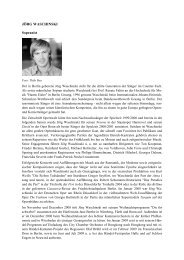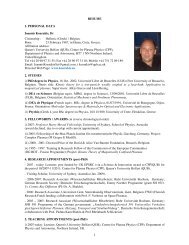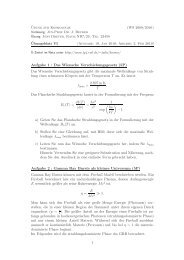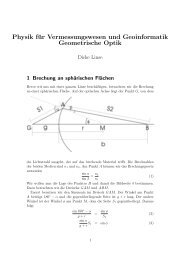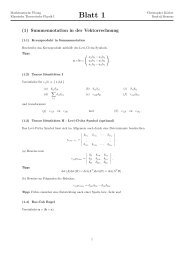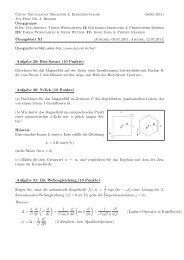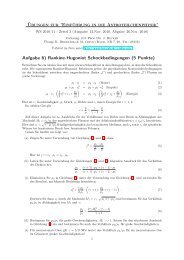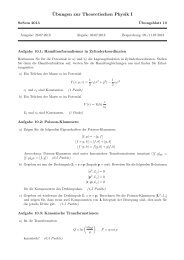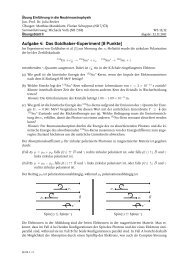View - Theoretische Physik IV - Ruhr-Universität Bochum
View - Theoretische Physik IV - Ruhr-Universität Bochum
View - Theoretische Physik IV - Ruhr-Universität Bochum
Create successful ePaper yourself
Turn your PDF publications into a flip-book with our unique Google optimized e-Paper software.
1 Introduction<br />
Large ensembles of interacting charged particles (plasmas) occur in a wide variety of physical<br />
contexts, ranging from Space (solar plasmas, interplanetary matter in plasma state) and stellar<br />
environments (neutron stars, pulsars) to the Earth’s atmosphere (lightnings, magnetospheric<br />
phenomena, waves in the ionosphere, noctilucent clouds) and from thermonuclear fusion reactors<br />
(Tokamaks) and laboratory (discharge plasmas, laser plasmas) even down to household<br />
applications (discharge light bulbs). A plasma, which is typically modeled as a collection of<br />
electrons and positive ions, is a complex physical system characterized by rich dynamics, which<br />
includes numerous collective effects (linear oscillation modes, nonlinear waves), instabilities, etc.<br />
Typical e-i plasmas are tacitly thought of as weakly-coupled systems, given the high temperature<br />
and low density values encountered in different natural plasma contexts [Balescu, 1988].<br />
The strength of interparticle interactions is quantitatively expressed by the coupling parameter<br />
Γ = e 2 /(k B T < r >), which represents the ratio of the average potential-to-kinetic energy of the<br />
charged particles; note that Γ increases (decreases) with density n (temperature T), since the<br />
mean interparticle distance < r >∼ n −1/3 is defined as the Wigner-Seitz radius of an elementary<br />
particle sphere volume, viz. 4πr 3 WS /3 = 1/n (k B denotes the Boltzmann constant). For most<br />
e-i plasmas of interest in space and laboratory, Γ attains very low values (Γ ∼ 10 −5 −10 −4 ≪ 1)<br />
justifying this weak-coupling hypothesis. However, strongly-coupled plasmas, so far thought to<br />
exist only in exotic environments (such as neutron stars), have recently been created in laboratory,<br />
e.g. ultra-cold plasmas of laser-cooled ions, in Penning traps and storage rings (see<br />
[Killian, 2004] and Refs. therein), which freeze at ultra-low temperatures (T ≪ 1 o K) to form<br />
Wigner crystals, where Γ attains high values (Γ > 170 sets the theoretical crystallization limit<br />
[Ikezi, 1986]; values as high as Γ ≃ 10 3 − 10 4 are today observed in all of the systems mentioned<br />
here). A similar lattice ordering is exhibited by dusty plasmas (DP), produced during discharge<br />
plasma experiments; this exciting mesoscopic system will atract our attention in the following.<br />
Dusty plasmas (or complex plasmas) consist of electrons e − (mass m e , charge q e = −e),<br />
ions i + (mass m i , charge q i = +Z i e) and massive (M d ≃ 10 9 m p , typically, where m p is the<br />
proton mass), heavily charged (Q d = ±Z d e, where Z d ≃ 10 3 − 10 4 , typically), micron-sized<br />
(typical diameter 10 −2 − 10 2 µm) defects, i.e. dust particulates d − (or, less often, d + ). The<br />
presence of the latter modifies the plasma properties substantially [Verheest, 2001; Shukla &<br />
Mamun, 2002] and allows for new charged matter states, including liquid-like phases and even<br />
solid (quasi-crystalline) configurations [Shukla & Mamun, 2002; Morfill et al., 1999; Morfill et<br />
al., 2002], first realized independently by three experimental groups in 1994 [Chu & I, 1994;<br />
Hayashi & Tachibana, 1994; Thomas et al., 1994].<br />
Dust quasi-lattices are typically formed in the sheath region above the negative electrode in<br />
discharge plasma experiments (see in [Morfill et al., 1997] for a review of the technical details<br />
and main results), and remain horizontally suspended at a levitated equilibrium position (at<br />
z = z 0 , say) where gravity and electric (and/or magnetic [Yaroshenko, 2004]) forces mutually<br />
balance each other 3 . Typical lattice configurations include bcc, fcc and hcp patterns, consisting<br />
of roughly a dozen horizontal two-dimensional (2d) layers; simpler one-dimensional (1d)<br />
arrangements were also produced in laboratory, by applying appropriate confinement potentials<br />
[Misawa et al., 2001; Liu et al., 2003], and are thought to provide a basis for future applications.<br />
From a fundamental point of view, these crystal-like structures are a most challenging physical<br />
system, since basic issues like the very nature of inter-particle interaction or the char-<br />
3 it is worth mentioning that DP lattice experiments are also currently carried out in microgravity conditions,<br />
in the International Space Station; we shall not focus in this issue here.




